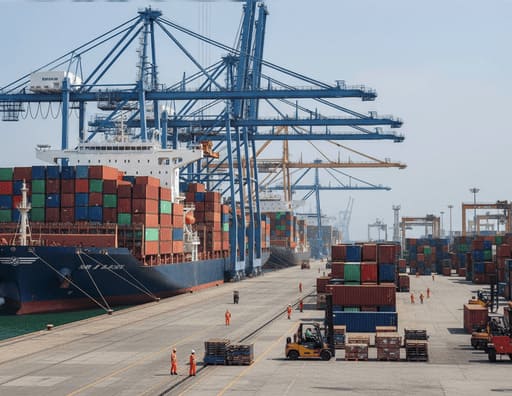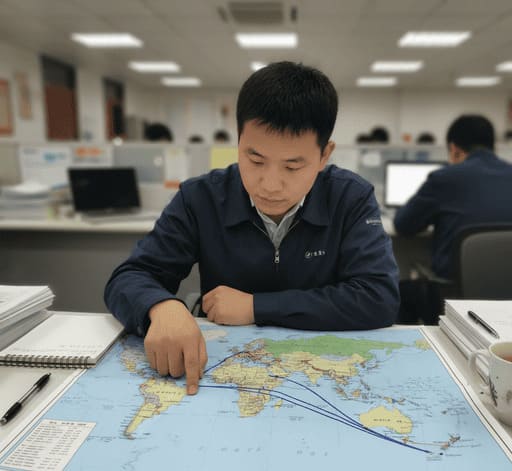Finding dependable container shipping from China to the USA can feel impossible. Bad carriers lead to missed deadlines, damaged goods, and lost shipments—potentially costing your business thousands in sales and damaged customer relationships.
Reliable container shipping providers from China to the USA include global carriers like Maersk Line, MSC, COSCO Shipping, CMA CGM, and Evergreen Line. Reputable freight forwarders offering container services include JojoShip China, Yamatohk, and AEB Logistics. These companies provide consistent transit times, tracking capabilities, and customs support.

Over my years running JojoShip China and managing thousands of container shipments between China and the USA, I've developed relationships with the most reliable carriers in the market. Let me share my insights on who you can trust, based on real performance data rather than just marketing claims.
How Much Does It Cost To Ship A 40FT Container From China To USA?
Container shipping costs can make or break your profit margins. Many importers get shocked when final bills arrive with unexpected charges that weren't included in initial quotes1.
Shipping a 40FT container from China to USA typically costs between $5,000-$10,000 for door-to-door service. This includes $3,000-$6,000 for ocean freight, plus origin charges ($500-$1,000), destination charges ($800-$1,500), customs clearance ($200-$500), and inland delivery ($500-$2,000). Rates fluctuate seasonally and by route.

Container shipping costs have stabilized somewhat after the extreme volatility we saw during the pandemic, but they remain subject to significant fluctuations. Based on thousands of shipments I've managed at JojoShip China, I've compiled current cost ranges that can help you budget more accurately.
The total cost of shipping a 40ft container from China to the USA includes several components that are often omitted from initial quotes:
| Cost Component | Typical Range | What Affects This Cost |
|---|---|---|
| 海上貨物 | $3,000-$6,000 | Season, fuel prices, port pairs |
| Origin Charges | $500-$1,000 | Origin port, documentation, container stuffing |
| Destination Charges | $800-$1,500 | Destination port, terminal handling, exams |
| 通関手続き | $200-$500 | Complexity, bond requirements |
| Inland Delivery | $500-$2,000 | Distance from port, accessibility |
| Insurance | $200-$500 | Cargo value, coverage type |
These costs vary significantly depending on several key factors:
-
Port Pairs: The specific ports you're shipping between make a substantial difference. For example:
Origin Port 目的地ポート Typical Base Rate Shanghai Los Angeles $3,000-$5,000 Ningbo Long Beach $3,000-$5,000 Shenzhen Oakland $3,500-$5,500 Qingdao New York $4,500-$7,000 Xiamen Seattle $3,500-$5,500 -
季節変動2: Prices typically increase during:
- Peak season (August-October) leading up to holiday shopping
- Chinese New Year (January-February)
- End of quarters when importers rush shipments
-
Special Cargo Requirements4: Hazardous materials, oversized cargo, or refrigerated containers will incur additional fees.
-
Container Type: While standard 40ft containers (40GP) are most common, high-cube containers (40HQ) often cost about the same while providing additional vertical space.
One critical insight I've gained from managing shipping for hundreds of businesses is that the cheapest quote is rarely the best value. Some carriers and forwarders offer attractively low base rates but add substantial charges later for services that should be included. At JojoShip China, we provide all-inclusive quotes that prevent these surprises.
For businesses importing consistently, I recommend negotiating annual contracts with your freight forwarder5. This approach typically saves 10-15% compared to spot rates and provides much better predictability for your supply chain planning.
How Long Does It Take For A Container Ship To Get From China To The United States?
Transit time uncertainty6 wreaks havoc on inventory planning. Many businesses suffer stockouts or excess inventory because they can't accurately predict when shipments will arrive.
Container ships typically take 14-20 days from China to West Coast USA (Los Angeles, Long Beach) and 30-35 days to East Coast (New York, New Jersey) via the Panama Canal. Total door-to-door transit time, including inland transport and customs clearance, ranges from 25-45 days depending on the route and potential delays.

Understanding realistic transit times is crucial for effective inventory planning. From my experience managing JojoShip's container shipping operations, I can share detailed insights on current timelines and the factors that affect them.
The ocean transit portion represents only part of the total shipping time. A complete door-to-door timeline typically includes:
-
Production & Export Preparation:1-3日
- Container pickup and stuffing
- 輸出通関
- Delivery to port
-
オーシャン・トランジット: Varies by route
- China to US West Coast: 14-20 days
- China to US East Coast: 30-35 days
- China to US Gulf Coast: 35-40 days
-
Arrival Processing: 2-7 days
- Port congestion and unloading
- 輸入通関
- Container availability
-
Inland Delivery: 1-7 days depending on distance
These transit times vary significantly based on several factors:
| ファクター | 所要時間への影響 | Example |
|---|---|---|
| Port Congestion7 | +0-14 days | Los Angeles often experiences congestion during peak season |
| Customs Holds | +1-10 days | Random inspections or documentation issues |
| Routing | +0-15 days | Direct services vs. transshipment routes |
| Weather | +0-7 days | Typhoon season in Asia can cause delays |
| 機材供給 | +0-5 days | Container shortages can delay pickup |
Shipping from South China ports (Shenzhen, Guangzhou) typically adds 1-2 days compared to East China ports (Shanghai, Ningbo) when heading to the US West Coast.
One strategy I often recommend to clients with time-sensitive shipments is selecting premium services offered by major carriers8. These services, though 10-15% more expensive, often guarantee fixed transit times and priority unloading at destination ports, potentially saving days or even weeks during busy periods.
For businesses importing from multiple suppliers across China, 統合9 represents another potential time-saver. By coordinating pickups and consolidating goods into a single container, you can avoid the longer transit times associated with LCL (Less than Container Load) shipments, which typically add 5-10 days due to de統合4 at destination.
Another important consideration is the reliability factor of different carriers. Based on JojoShip's performance tracking:
| キャリア | On-Time Performance | Average Delay When Late |
|---|---|---|
| マースク | 75-85% | 2-4 days |
| MSC | 70-80% | 3~5日 |
| CMA CGM | 70-80% | 3~5日 |
| COSCO | 65-75% | 4-6 days |
| Evergreen | 70-80% | 3~5日 |
These reliability metrics fluctuate quarterly, which is why working with an experienced freight forwarder who tracks this data can help you select the most punctual carrier for your specific route.
Is Sea Or Air Freight Better From China?
Choosing between air and sea freight confuses many importers. The wrong decision can either destroy your margins with excessive shipping costs or leave you with crippling inventory shortages.
Sea freight is better for large, heavy shipments with flexible timelines, costing $0.50-$3/kg but taking 25-45 days. Air freight is superior for urgent, valuable, or time-sensitive goods, costing $3-$8/kg with 5-10 day transit times. The optimal choice depends on shipment value, weight, urgency, and seasonal factors.

The sea versus air freight decision is one I help clients make daily at JojoShip China. There's no universal answer—it depends entirely on your specific business needs and shipment characteristics.
Here's a comprehensive comparison to guide your decision:
| ファクター | Sea Freight | 航空貨物 |
|---|---|---|
| Cost per kg | $0.50-$3 | $3-$8 |
| トランジットタイム | 25-45 days | 5~10日 |
| Minimum Size | Typically 1 CBM | No practical minimum |
| Carbon Footprint | Lower per kg | 20-30x higher per kg |
| Reliability | More weather/congestion delays | More consistent schedules |
| Damage Risk | Slightly higher | Lower |
| 最適 | Large, heavy, non-urgent | Small, light, urgent, valuable |
Beyond these basic comparisons, several considerations should influence your decision:
-
Product Value-to-Weight Ratio10: Higher-value products often justify air freight because:
- Reduced inventory carrying costs
- Lower insurance costs (shorter time at risk)
- Faster cash conversion cycle
-
Seasonality:
- During peak season (August-October), ocean freight space becomes limited and rates increase
- Air freight provides more flexibility for reacting to sudden demand changes
- Chinese New Year affects both options but sea freight backlog lasts longer
-
Inventory Management Strategy:
- Just-in-time inventory models11 often require air freight
- Forecasted demand can utilize sea freight's lower costs
-
Product Characteristics:
- Perishable or trend-sensitive items benefit from air freight
- Heavy machinery or bulk materials are typically more economical via sea
For many of my clients, a ハイブリッド・アプローチ12 works best. For example, a fashion retailer might:
- Ship 80% of seasonal inventory by sea freight well in advance
- Reserve air freight capacity for 20% to adjust based on early sales data
- Use express shipping for emergency replenishment of bestsellers
This balanced strategy minimizes overall logistics costs while maintaining flexibility.
One important calculation I recommend is the "total landed cost per unit13" comparison between air and sea freight. This factors in:
- Direct shipping costs
- Inventory carrying costs (capital tied up during transit)
- Warehousing expenses
- Potential lost sales from stockouts
- Product obsolescence risk
For high-value electronics with fast depreciation, air freight often proves cheaper in total landed cost despite the higher direct shipping expense. For stable, commodity-type products, sea freight almost always wins this calculation.
At JojoShip China, we've also developed a "break-even urgency calculator14" that determines exactly how urgently you need items to justify the air freight premium. If your true need date allows sea freight, you can often save 70-80% on shipping costs.
How To Find A Reliable Freight Forwarder In China?
Working with an unreliable freight forwarder can turn importing into a nightmare. Many businesses waste thousands of dollars and countless hours dealing with missed pickups, poor communication, and lost shipments.
To find a reliable freight forwarder in China: research companies with both Chinese and US presence, verify licensing and credentials, check references from current customers, evaluate their communication quality and transparency, assess their technology platforms, understand their carrier relationships, and test their service with a small shipment before committing.

Finding a trustworthy freight forwarder in China is perhaps the most important decision you'll make in your importing journey. Through building JojoShip China and helping hundreds of businesses establish reliable supply chains, I've developed a systematic approach to identifying quality partners.
Here's my step-by-step process for finding a reliable freight forwarder:
-
Verify Credentials and Experience
- Check for proper licensing (NVOCC license15, FMC registration for US operations16)
- Confirm membership in industry associations (WCA, FIATA)17
- Verify years of experience on the China-US route specifically
- Research company history and stability
-
Assess Operational Capability
- Physical presence in both China and USA
- Network of offices or agents in key locations
- Strong relationships with major carriers18
- Customs brokerage capabilities
- Warehouse facilities (if needed)
-
Evaluate Communication and Technology
- Responsiveness to inquiries (test this before committing)
- English proficiency of key staff
- Time zone coverage for your business hours
- Quality of tracking and visibility systems19
- Client portal or digital tools availability
-
Review Service Quality Indicators
- Ask for references from current clients
- Check online reviews and testimonials
- Industry reputation (ask in relevant forums)
- Performance metrics (on-time rates, claims handling)20
- Transparency about potential issues
When evaluating potential freight forwarders, these red flags should warn you away:
| Warning Sign | Why It Matters |
|---|---|
| Extremely low quotes | Often leads to hidden charges later |
| No physical address | May be a booking agent, not a true forwarder |
| Unclear pricing structure | Makes budgeting impossible |
| Poor responsiveness during inquiry | Will worsen once they have your business |
| No references available | May be new or have unsatisfied customers |
The most reliable freight forwarders typically offer these value-added services:
-
Supply Chain Consultation21 - Advice on optimizing routes, consolidation opportunities, and inventory planning
-
Customs Expertise22 - Guidance on HS code classification, documentation requirements, and compliance
-
Flexible Solutions - Ability to handle various shipment sizes and types
-
Problem Resolution - Proactive handling of delays, customs issues, or carrier problems
-
Transparent Technology - Real-time visibility into shipment status and documentation
I always recommend starting with a smaller test shipment before committing your entire supply chain to a new forwarder. This allows you to evaluate their performance with lower risk. At JojoShip China, we encourage this approach with new clients because we're confident in our service quality.
Another effective strategy is to ask detailed, scenario-based questions during your evaluation:
- "What exactly happens if my shipment is selected for customs examination?"
- "How do you handle port congestion during peak season?"
- "What's your process if a supplier isn't ready when the container arrives?"
The quality and specificity of their answers will reveal their experience level and problem-solving capabilities.
Remember that the cheapest freight forwarder is rarely the best value. Experienced importers know that reliability, communication, and problem-solving ability often save far more money than the lowest quoted rate.
結論
Reliable container shipping from China to the USA requires selecting the right partners. The best providers combine established carrier relationships, transparent pricing, proven track records, and end-to-end visibility. Prioritize reliability over cost alone for long-term importing success.
-
Understanding hidden fees helps you avoid surprise costs and budget more accurately for your shipments. ↩
-
Knowing when rates spike helps you plan shipments to avoid peak pricing and save money. ↩
-
Fuel surcharges can significantly impact your shipping costs; understanding them helps you anticipate price changes. ↩
-
If you ship hazardous or oversized goods, knowing these fees helps you budget and comply with regulations. ↩ ↩
-
Annual contracts can save you money and provide stability; learn how to negotiate better shipping terms. ↩
-
Learn how unpredictable shipping times can disrupt your inventory management and discover strategies to minimize stockouts and excess inventory. ↩
-
Explore how port congestion can add significant delays and what you can do to mitigate its impact on your shipments. ↩
-
Find out how premium services can guarantee faster and more reliable delivery, potentially saving days or weeks during busy periods. ↩
-
Discover how consolidating goods can reduce transit times and costs, especially for businesses importing from multiple suppliers. ↩
-
Learn why the value-to-weight ratio of your goods can determine whether air or sea freight is more cost-effective for your business. ↩
-
Explore how just-in-time inventory strategies influence whether air or sea freight is the best fit for your supply chain. ↩
-
See how combining air and sea freight can optimize costs and flexibility, especially for businesses with fluctuating demand or urgent needs. ↩
-
Understanding total landed cost per unit helps you make smarter shipping decisions by factoring in all expenses, not just freight rates. ↩
-
Discover how a break-even urgency calculator can help you decide if paying extra for air freight is truly justified for your shipment. ↩
-
Understanding the NVOCC license helps ensure your freight forwarder is properly authorized and compliant with international shipping regulations. ↩
-
FMC registration is crucial for legal and secure shipping to the US, protecting your business from regulatory issues and potential shipment delays. ↩
-
Industry association membership signals credibility and access to global networks, reducing risks and improving service quality for importers. ↩
-
Carrier relationships can lead to better rates, priority space, and smoother shipping, directly benefiting your supply chain reliability. ↩
-
Advanced tracking systems provide real-time updates, reducing uncertainty and allowing you to manage your shipments proactively. ↩
-
Performance metrics reveal a forwarder's reliability and ability to resolve issues, helping you avoid costly delays and losses. ↩
-
Expert supply chain advice can optimize your logistics, reduce costs, and improve efficiency, making your importing process smoother. ↩
-
Customs expertise ensures compliance, reduces risk of delays, and helps you navigate complex regulations for seamless importing. ↩




